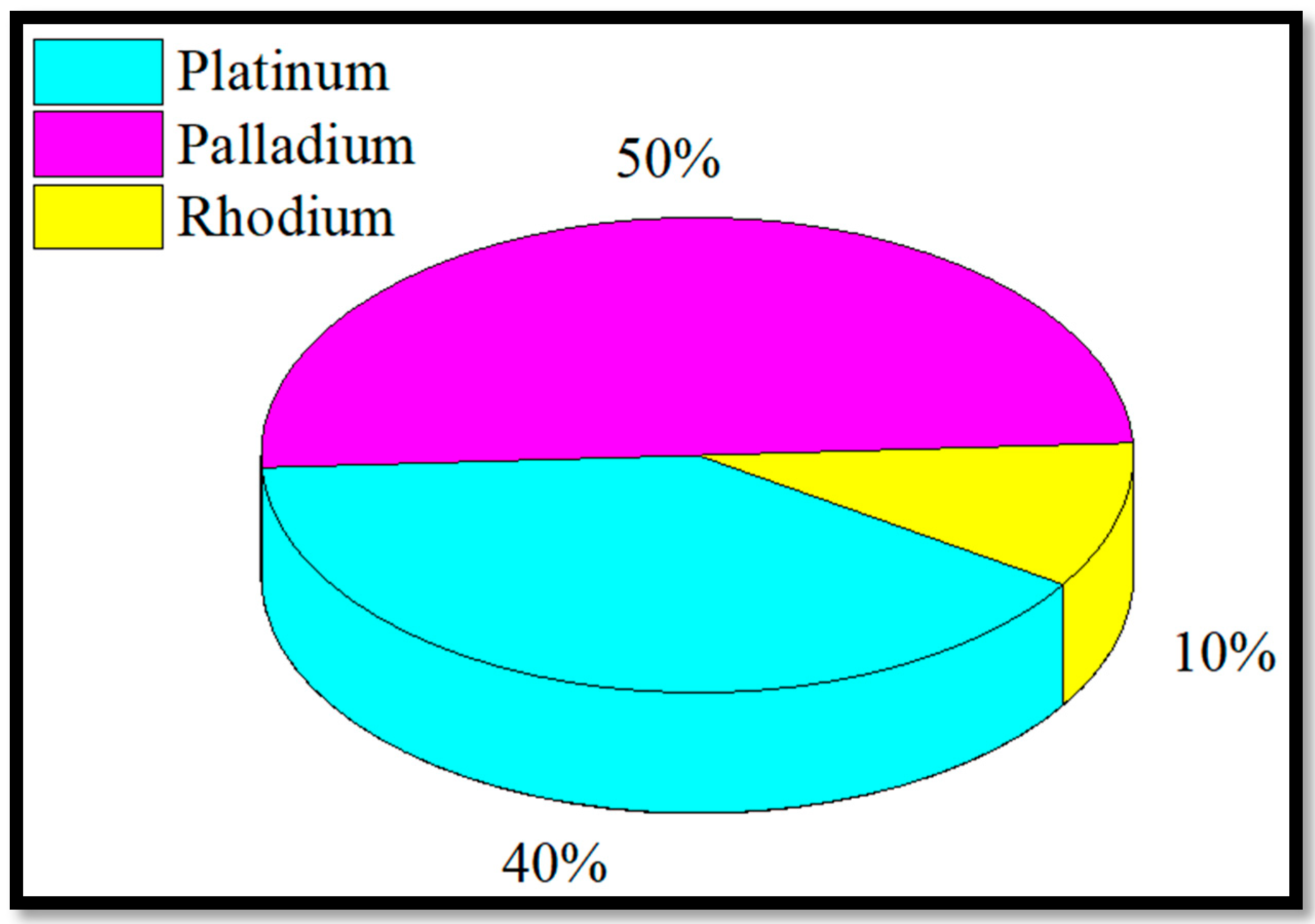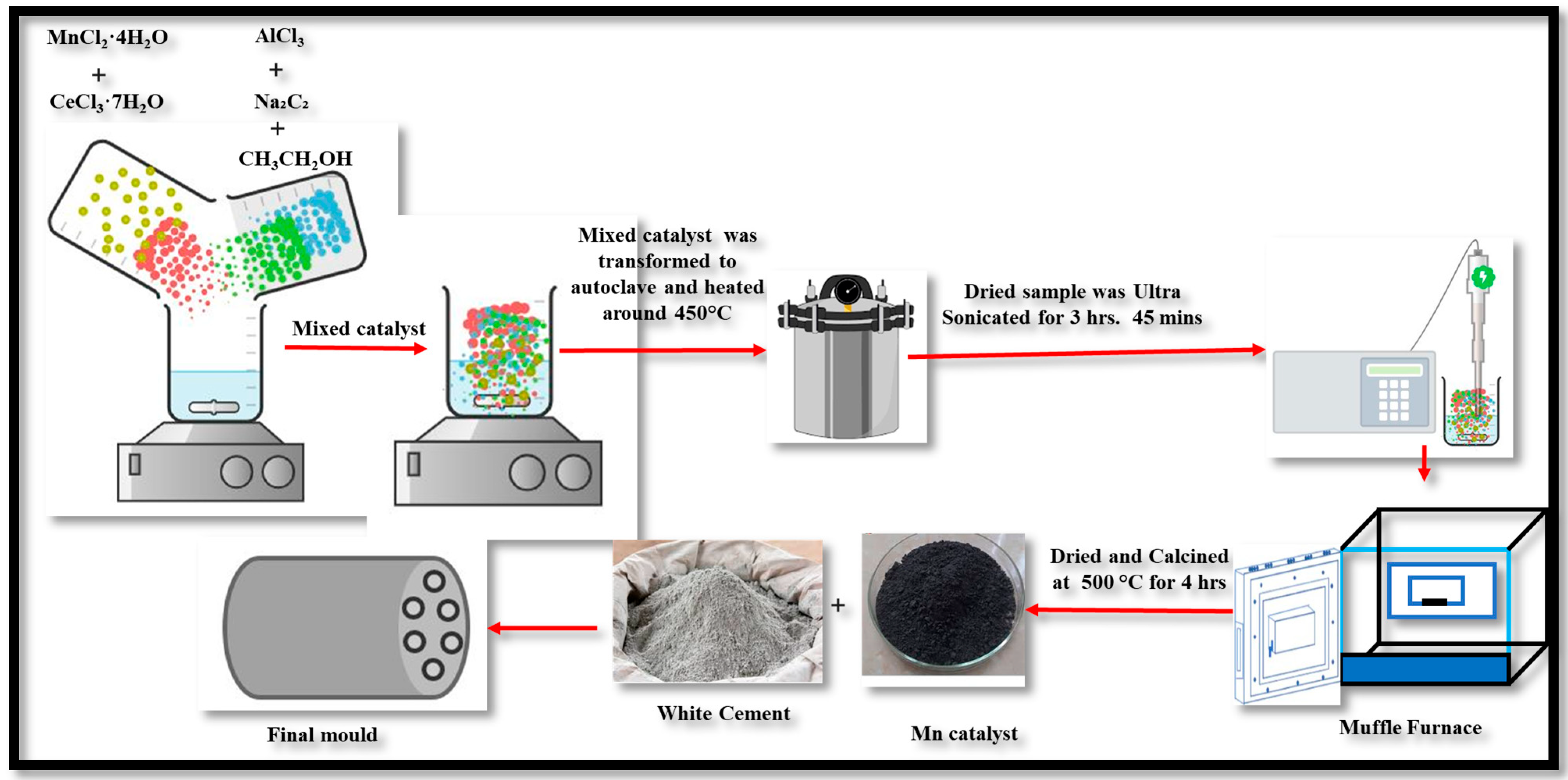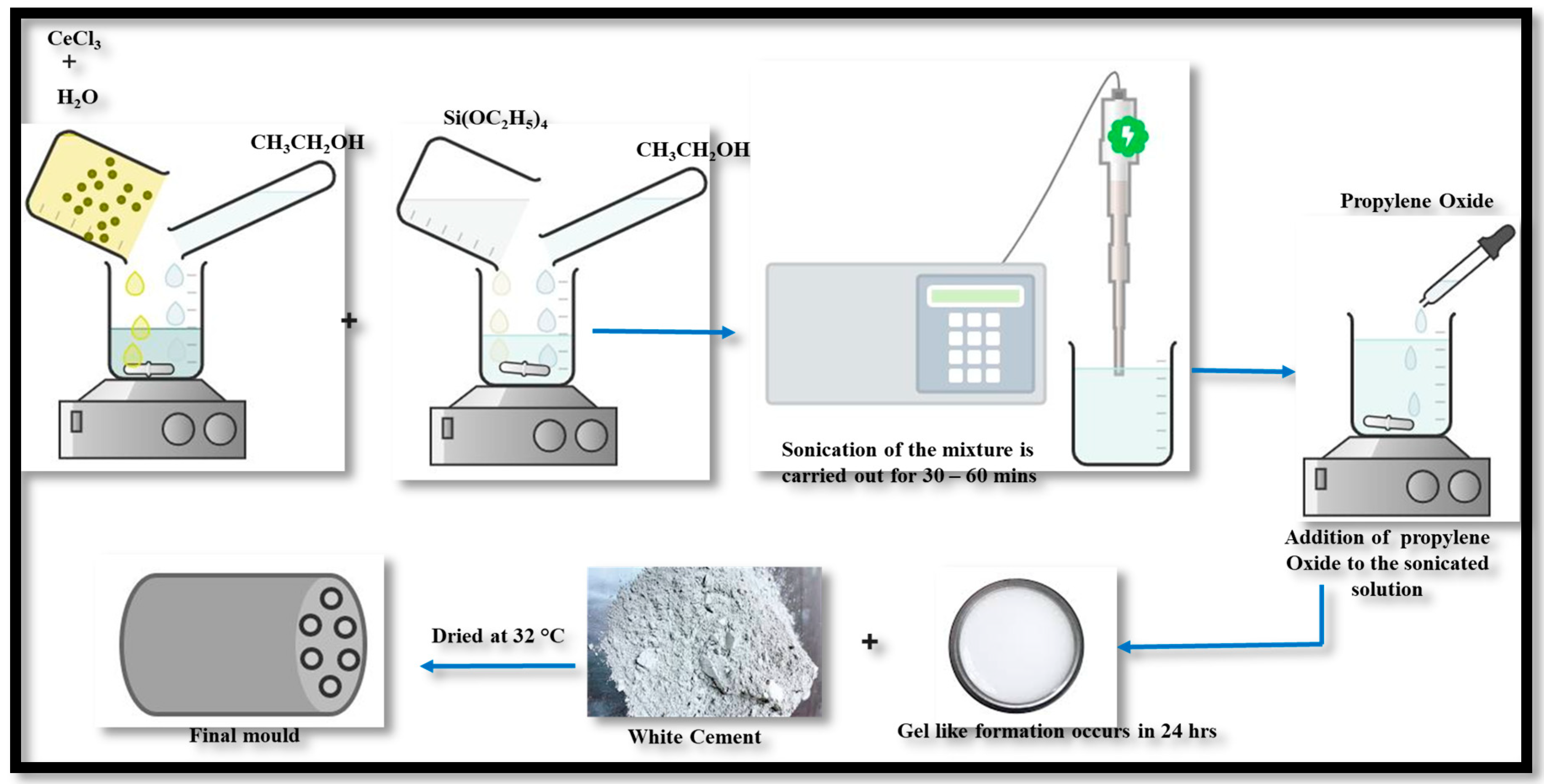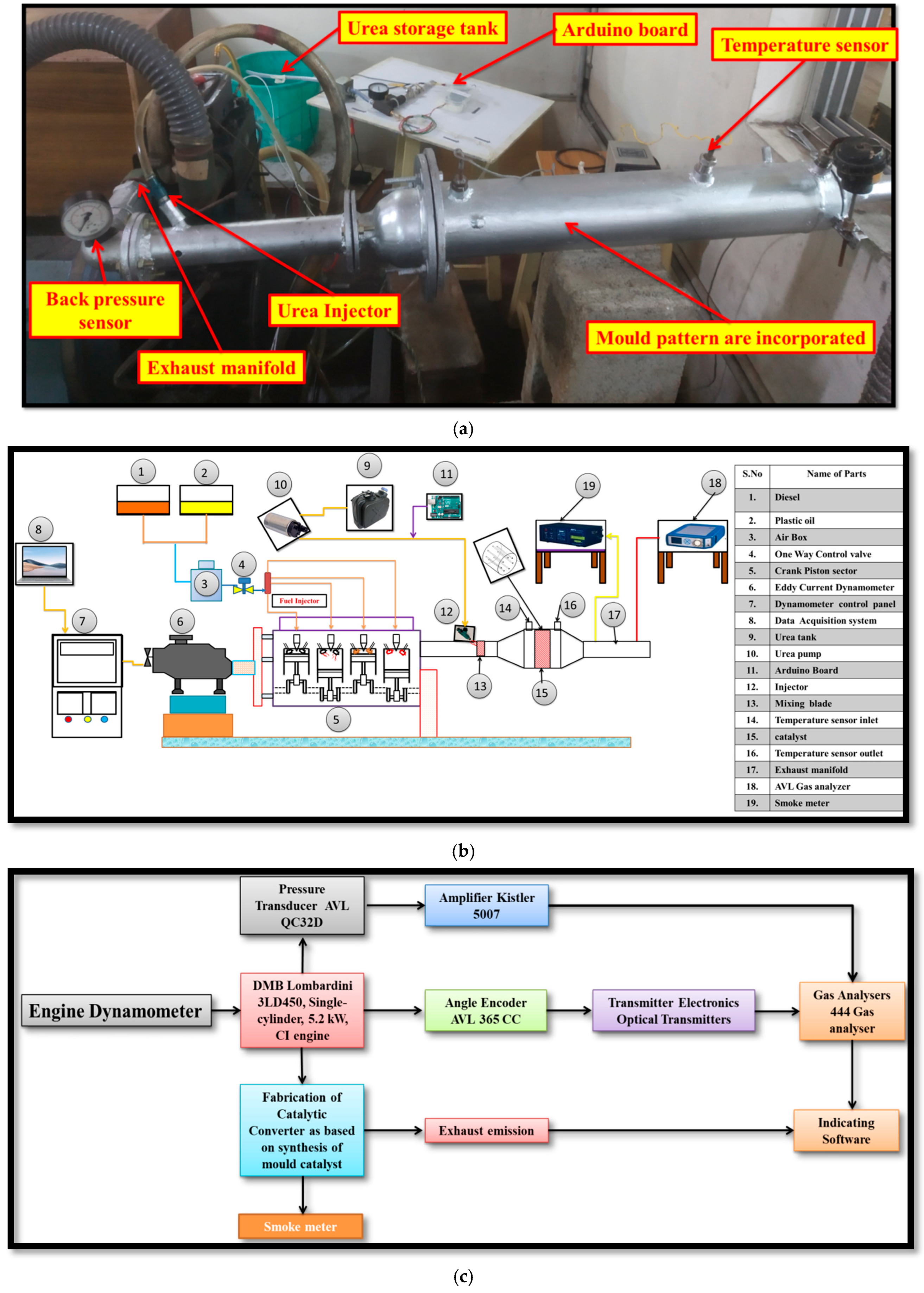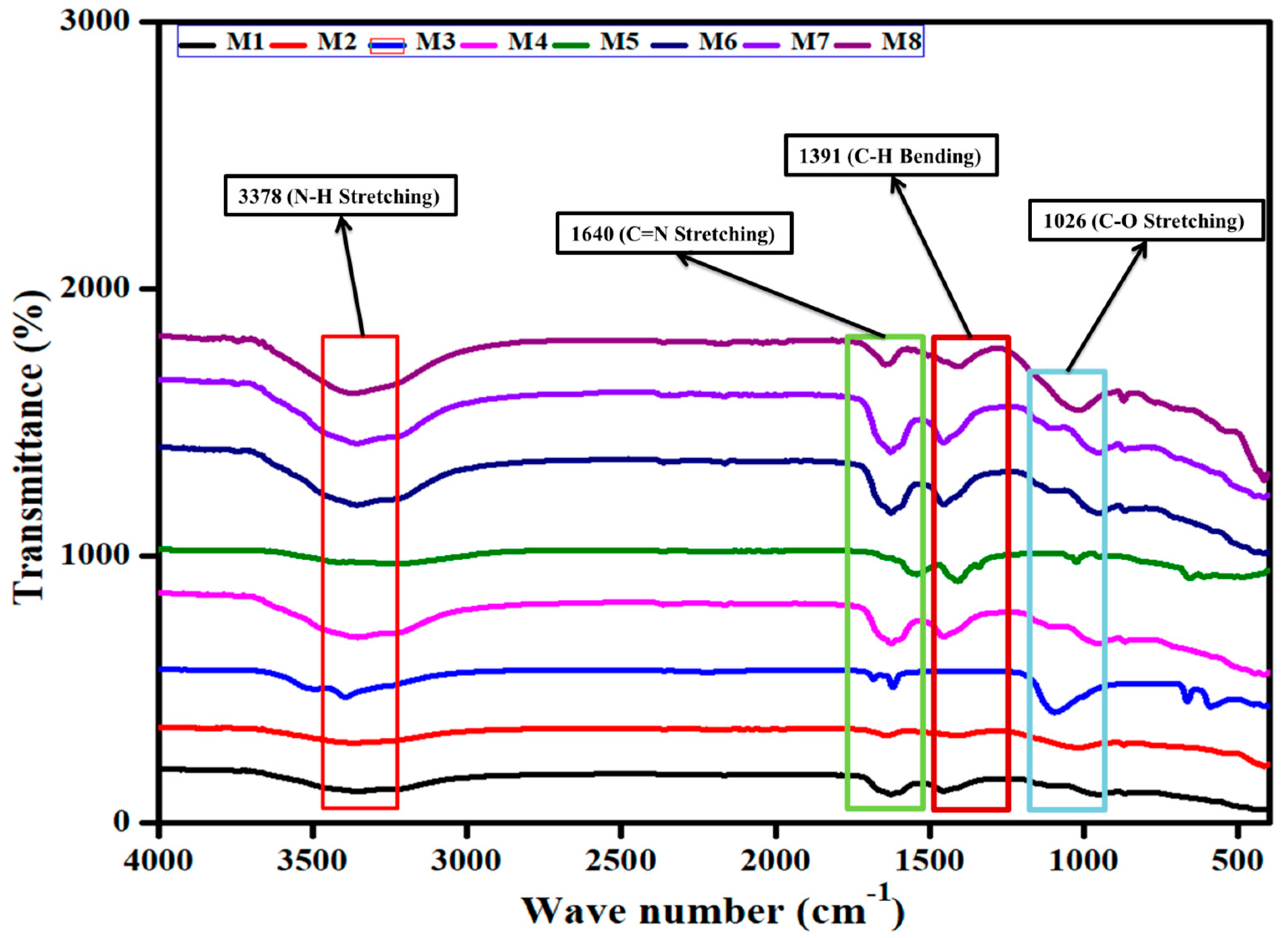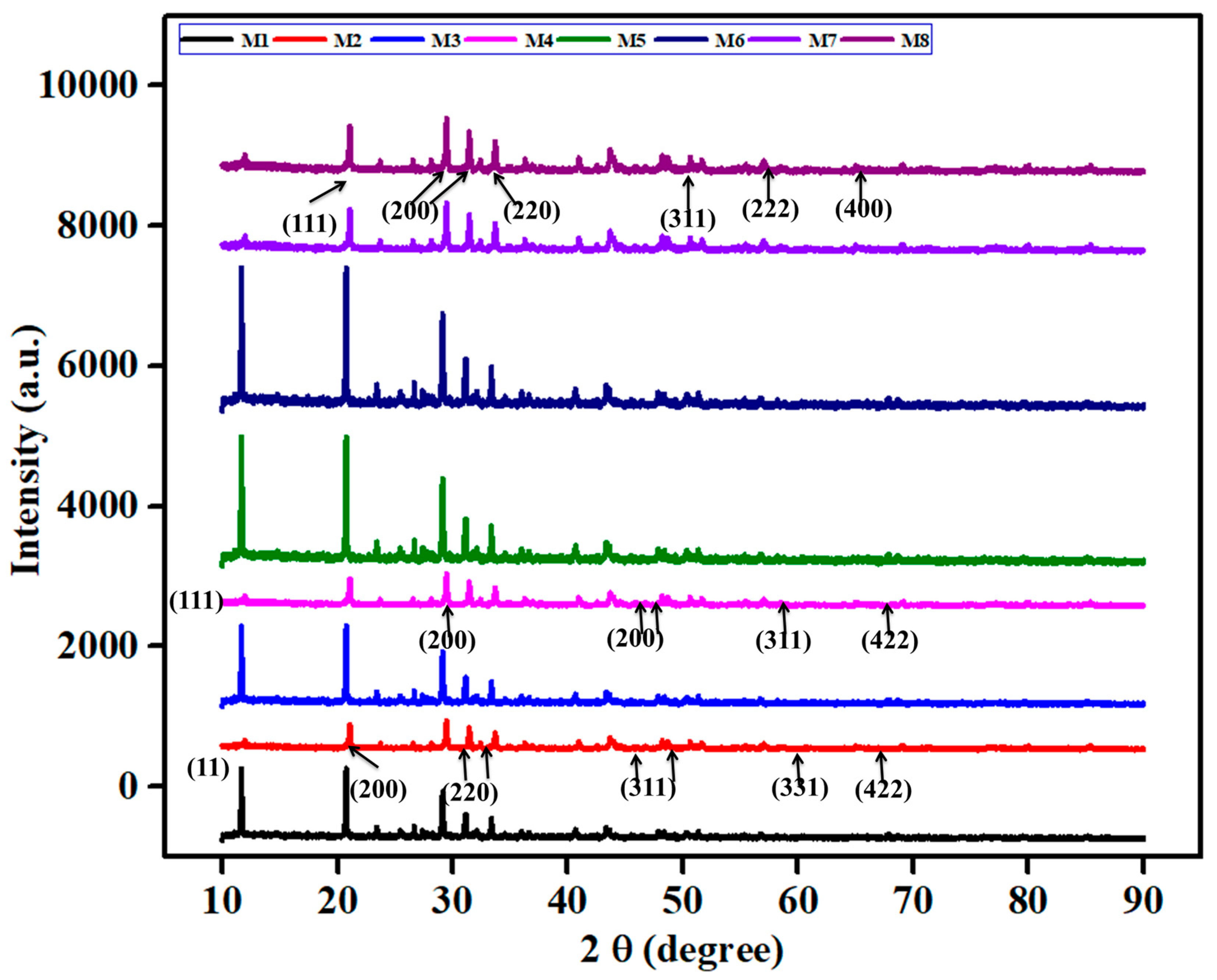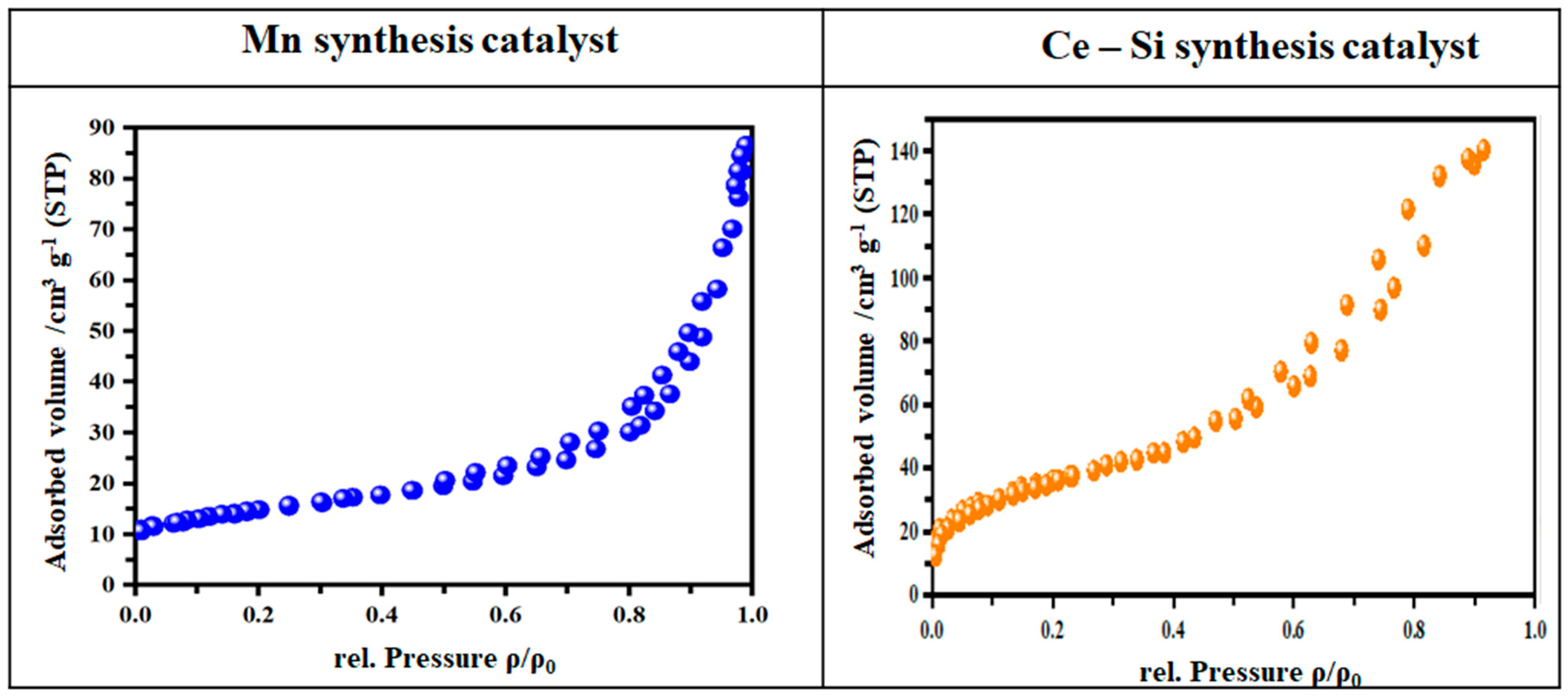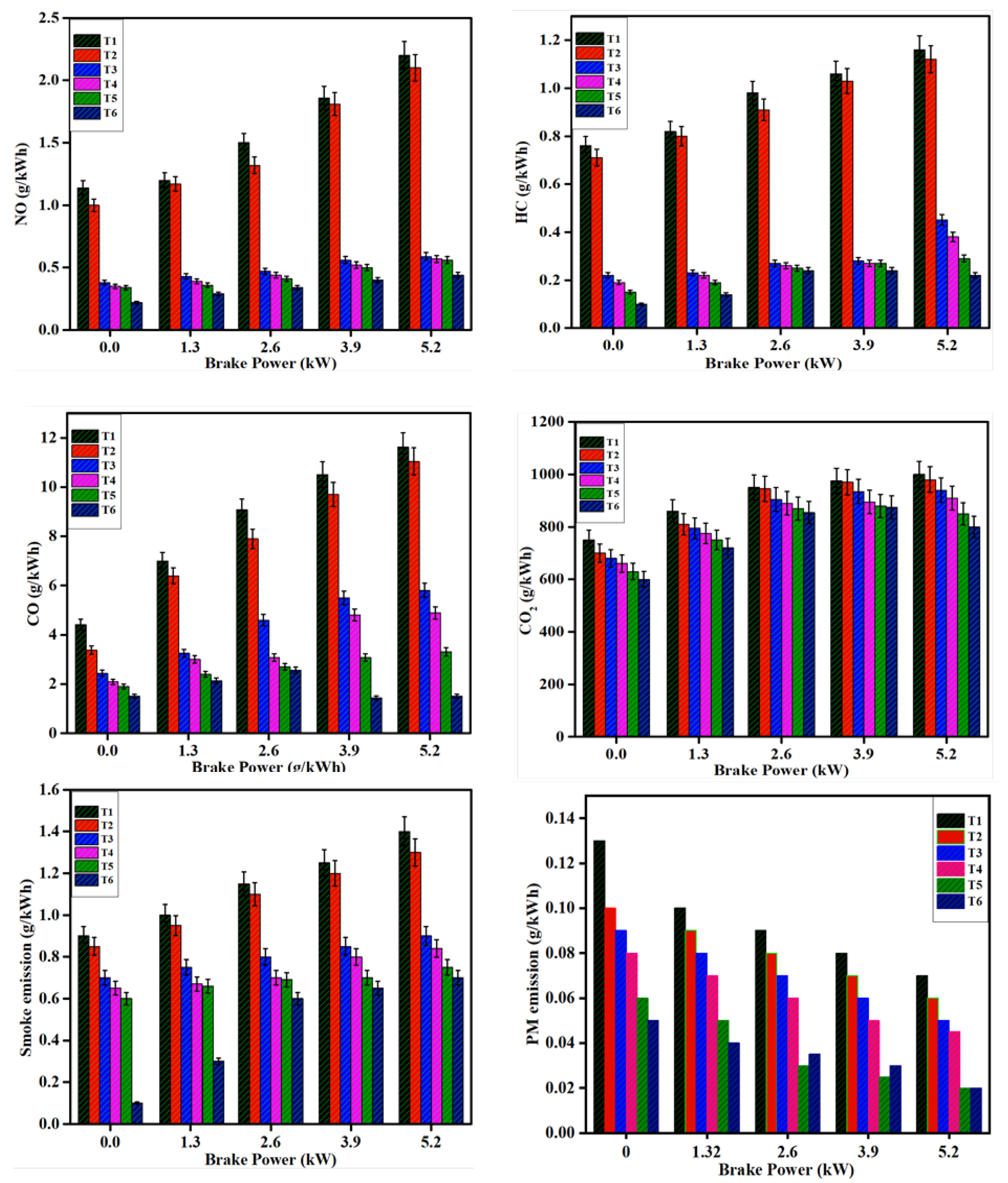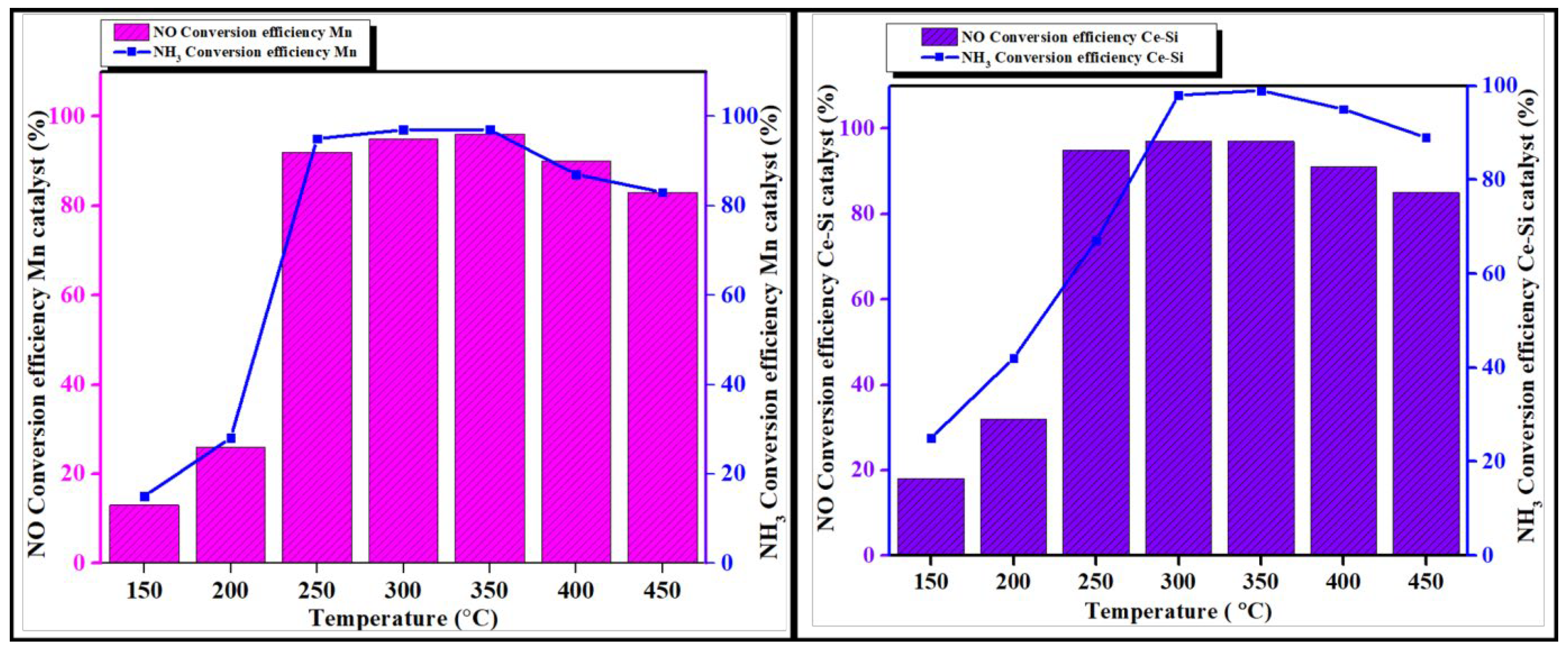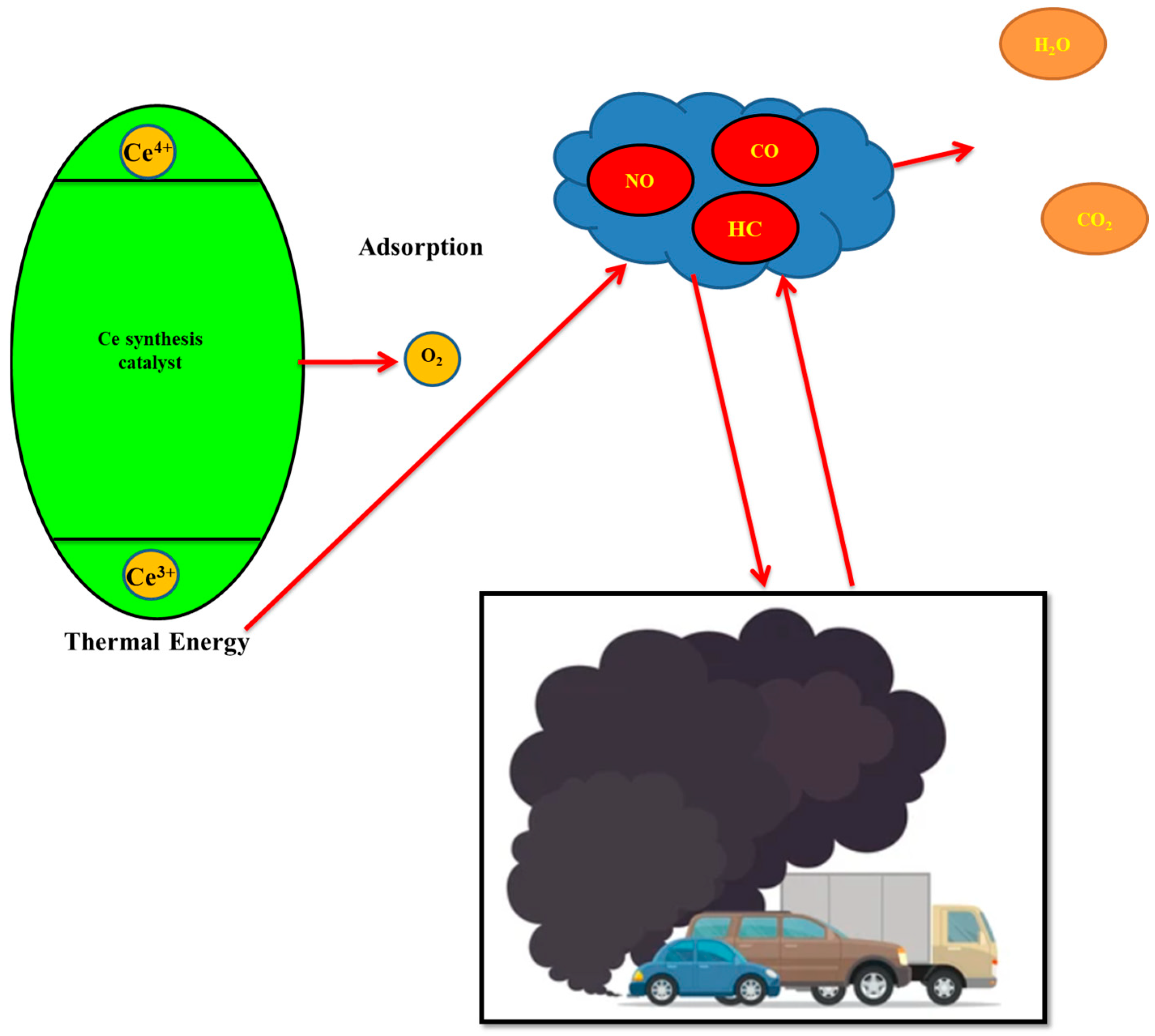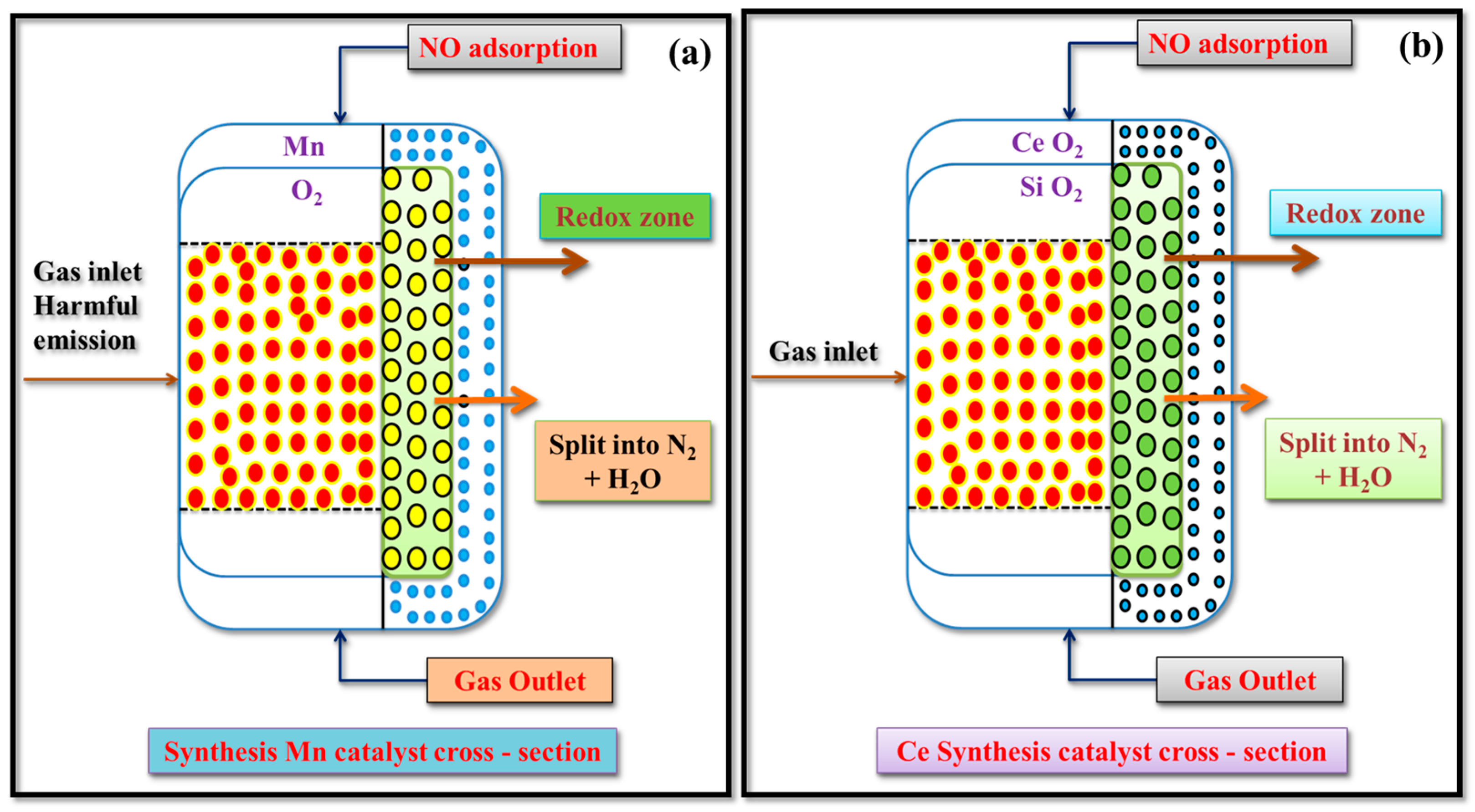3.5.1. Exhaust Emissions
Exhaust emissions were investigated in diesel and DPB fuels utilized engines with Mn and Ce-Si-based molds under minimum and maximum load conditions, and the obtained readings are depicted in
Figure 9. The Mn- and Ce-Si-based molds were evaluated for their effectiveness in reducing NO exhaust emissions. The Mn-based mold shows a lower pore structure and volume than the Ce-Si-based mold, which exhibits a higher pore structure and adsorption capacity. The Ce-Si-based mold is highly efficient for NO emission reduction [
35]. Compared to trial T1, NO emissions are reduced by 66.67%, 69.29%, 70.17%, and 80.70% for trials T3 to T6, respectively, under minimum load conditions. The same is further reduced by 73.18%, 74.09%, 74.54%, and 80%, for trials T3 to T6 when compared with T1 under maximum load conditions.
Under minimum load conditions, HC emissions demonstrate significant reductions when compared to trial T1. Specifically, reductions of 71.05%, 75%, 80.26% and 86.84% were observed for trials T3, T4, T5, and T6, respectively. Under maximum load conditions, HC emissions were further reduced by 61.20%, 67.04%, 75%, and 81% for trials T3, T4, T5, and T6 compared to T1. For CO emissions under maximum load conditions, reductions of 44.67%, 52.60%, 56.68% and 65.75% were recorded for trials T3, T4, T5, and T6, respectively. Under maximum load conditions, these reductions increased to 50%, 57.91%, 71.48% and 87% for trials T3 to T6 in comparison to T1.
CO2 emissions also exhibited a notable decrease. Under minimum load conditions, reductions of 9.33%, 12%, 16%, and 20% was observed for trials T3, T4, T5 and T6, respectively, relative to T1. Similarly, under maximum load conditions, CO2 emissions were reduced by 6%, 9%, 15%, and 20% for trials T3 and T6 compared to T1.
Smoke emissions followed a similar trend. Under maximum load conditions, reductions of 22.22%, 27.77%, 33.33% and 88.88% was achieved for trials T3, T4, T5, and T6, respectively, relative to T1. Under maximum load conditions, the reduction was 35.71%, 40%, 46.42% and 50% for trials T3 to T6 when compared with T1.
PM emissions followed a similar trend. Under maximum load conditions, reductions of 16.66%, 27.77%, 50.50% and 75.00% was achieved for trials T3, T4, T5, and T6, respectively, relative to T1. Under maximum load conditions, the reduction was 35.71%, 40%, 46.42% and 50% for trials T3 to T6 when compared with T1.
The experimental results thoroughly highlight the relative performance of the Mn and Ce-Si synthesis catalyst-based molds over the maximum engine load conditions. The FTIR spectra show that the Ce-Si mold has substantially more intense adsorption bands associated to the nitrate and nitrite species, than the Mn-based mold, suggesting better NO adsorption and stronger redox behavior; the shift and intensity of these vibrational bands showed that the Ce-Si catalyst has a more efficient means of NO decomposition into nitrogen and oxygen, therefore directly assisting with NO abatement.
The XRD analyses showed that the Ce-Si mold has broader and less intense diffraction peaks compared to the Mn-based mold, suggesting better active species dispersion and more amorphous material, which leads to high catalytic activity and thermal stability. The apparent suppression of unwanted crystallization phases in the case of the Mn mold suggests that the Ce-Si system maintains structural integrity for the entire operating temperature range tested.
SEM micrographs show considerable differences in morphology between the two catalysts. The Ce-Si mold has a well-developed porous structure with high surface area and homogeneous particle dispersion and was determined to be durable under CC operation even after the exhaust gas had been flushed through. Although the Mn mold demonstrates a considerable reduction in structure, it remains to be seen if its degraded structure will hinder the performance of the Mn catalyst in refractory conditions typical of high-temperature exhaust.
Micrographs of the BET surface area and pore analysis confirm that the Ce-Si mold shows the best performance. The Mn mold has a slightly greater initial specific surface area, but the Ce-Si mold has a higher pore volume and more appropriate distribution of pore sizes for optimal gas diffusion, which significantly aids the access of reactants to the active sites. The observed difference in structure contributes to the trends seen in emissions reductions.
The analysis of engine exhaust emissions under both minimum and maximum loads shows that the SCR system combined with the Ce-Si mold will reduce NO, HC, CO, and smoke emissions significantly in both minimum and maximum loads with the DPB. Notably, NO emissions were reduced by as much as 80.70% under minimum load and 80% under maximum load, while HC emissions demonstrated reductions over 80% and CO emissions demonstrated reductions over 65%. The reforms in emissions validate that the Ce-Si catalyst helps not only to increase the effectiveness of pollutant conversion efficiencies, but also improves combustion quality.
Overall, the findings have been logically linked to the systematic relation of the physicochemical properties of the Ce-Si synthesis catalyst; i.e., its better oxygen storage capacity (OSC). The Ce-Si mold has higher redox behavior because of the reversible Ce3+/Ce4+ oxidation states that allow dynamic oxygen storage and release. This characteristic is directly related to the efficient conversion of NO into N2 and O2 during CC via continued redox cycles. In addition, the BET and SEM data indicate that the Ce-Si catalyst has a higher surface area and more pore volume for gas diffusion/availability to reactants at active sites. The XRD patterns show that the crystalline phase is well dispersed, which also supports that the Ce-Si matrix holds its stability and its accessibility to active sites when it comes to the exposed nature of exhaust gases. The FTIR data also indicate better bands for the adsorption of nitrates/nitrites, which demonstrates the Ce-Si material’s better OSC, as well as having a better adsorption capacity. All of the physicochemical properties contribute directly to the favorable NO reduction efficiency (up to 80.70%) and overall emissions reduction, which supports that both the intrinsic oxygen storage and redox capabilities of the catalyst give way to its catalytic efficiencies.
In summary, unique surface chemistry, crystalline stability, and favorable morphology allow the Ce-Si synthesis catalyst to deliver repeatable, effective emission control performance throughout a wide range of operating temperatures. Overall, these data validate the general performance of the Ce-Si catalyst, demonstrating that it can be a feasible and stable sustainable substitute for conventional pollutant emission control materials, improving the overall research goal of achieving the necessary environmental goals for stricter emissions standards and environmental sustainability.
PM emissions control solutions in diesel engines can be achieved through design, treatment, optimization, and upgrades. DPFs are used because of the various performance-based parameters they provide to accomplish complete oxidation of soot PM deposits that are contained within the diesel exhaust stream. DPFs are constructed from porous ceramic materials that hold the generated soot in place while allowing sufficient oxidation of the soot PM to occur. As with DPFs, CC and SCR units will reduce PM emissions by promoting the complete burn of unburned hydrocarbons to improve overall combustion quality. The use of rare-earth metal catalysts, such as the Ce-Si synthesis catalysts developed in this research, can promote PM emissions reductions based on their ability to store oxygen and have reversible redox states of Ce3+ and Ce4+. This new redox-based mechanism stores oxygen, which will provide active oxygen species to oxidize soot PM emissions into harmless and less harmful gases. The additional high surface area and porous structure used in the Ce-Si catalyst mold will retain appropriate gas diffusion to maximize contact between the exhaust fuel and active sites in the mold face, which will promote more consistent PM conversion during the exhaust cycle that can occur over temperature ranges of 150 °C to 600 °C.
Another important avenue for reducing PM from the source is improving combustion quality. This can be accomplished by blending diesel fuel with oxygenated fuels such as waste plastic oil, which helps increase atomization, provides better air–fuel mixing, and reduces zones of incomplete combustion which are where soot nuclei are generally found. Furthermore, optimizing operating conditions of the engine—by using the proper air–fuel ratio, using high-pressure multiphase injection, and retarding injection timing slightly—can help to reduce the formation of locally rich pockets of fuel where PM precursors originate. Also, EGR can be applied to reduce peak cylinder temperature to essentially suppress thermal cracking of heavier HC, leading to soot formation. Additionally, using catalytic fuel additives, such as cerium oxide nanoparticles, could help act in-cylinder to catalyze better completion of fuel oxidation which will help eliminate or reduce the carbon residue that leads to PM formation.
Together, a Ce-Si synthesis catalyst mold, a diesel–DPB and SCR treatment, as shown in this study, provide a strong and effective strategy for decreasing PM emissions. The experimental results make evident that the combined attributes of high redox activity, large surface area, enhanced pore volume, and thermal stability found in the Ce-Si catalyst contribute directly to reducing PM with proceeding reductions of other regulated emissions to support the compliance with tighter emission regulations and advance environmental sustainability, as shown in
Table 6.
